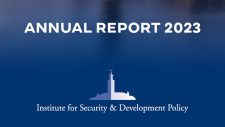Indo-Pacific Security in 2030-35: Links in the Chain

Jagannath Panda
In recent years, events like the COVID-19 pandemic and the Russia-Ukraine war have brought global supply chains squarely under the spotlight. The economic impact of these disruptive events exposed the vulnerabilities of today’s global value chains (GVCs) in the face of complex, uncertain, and fast-changing environments. In the Indo-Pacific particularly, the escalating geopolitical tensions threaten the stability of supply chains and, by extension, that of the global economy. As a major transit route for international trade – about 80% of the total global trade by volume passes through the region – the Indo-Pacific is of paramount strategic importance.
Most importantly, several sensitive technologies like semiconductors and critical materials like rare earth metals transit through the region, making this immensely vulnerable area vital for global value chains. As GVCs have been pushed to the top of the agenda, it has become critical for leaders – both in the government and in industries – to redesign and future-proof their supply chains to make them more resilient in the face of disruptions. This paper explores the future of critical supply chains. It seeks to understand the risk factors that GVCs face, and their vulnerabilities in the face of rising geopolitical tensions in the Indo-Pacific region, and how building mutually beneficial dependency into supply chains is critical to making them resilient to US–China strategic competition.
This policy paper was first published at The Hague Centre for Strategic Studies.
Related Publications
-
ISDP Annual Report 2023
ISDP’s Annual Report for the year 2023. We look back on 2023, a year in which tensions and conflicts captured the strategic space in ISDP’s focus areas, making headlines around […]
-
Navigating the Indo-Pacific: How Australia and the EU Can Partner for Peace, Stability, and Prosperity
To navigate the choppy waters of the Indo-Pacific, the EU and Australia must be on the same wavelength regarding shared interests in rules, values, and an open and liberal economic […]
-
EU-Thailand FTA Negotiations: IUU Fishing and Human Rights Remain Obstacles
Thailand’s fishing industry, which at its height saw as many as 200,000 migrant workers from neighboring Laos, Myanmar, and Cambodia caught in a brutal system of abuse, withered global criticism […]
-
The US and EU, and the Emerging Supply Chain Network: Politics, Prospects, and Allies
The Global Supply Chains have evolved from simply logistical achievements to being the bedrock of the global economy. Driven by technological advances and geopolitical shifts, this transformation underscores the critical […]
-
Japan’s Energy Security in the Persian Gulf: Caught Between New and Old Challenges
The goal of this paper is to investigate the evolution of Japan’s energy strategy in the Persian Gulf and understand how intra-Asian competition for business opportunities in the region can […]




